What Is an Environmental Audit? A Comprehensive Overview
Discover what an environmental audit is and its role in sustainability and compliance.

Overview:
An environmental audit is a systematic evaluation of a company's ecological performance and compliance with regulations, aimed at identifying areas for improvement and promoting sustainability. The article supports this by detailing how such audits lead to significant operational efficiencies, cost reductions, and enhanced accountability, as evidenced by statistics showing a 30% increase in efficiency and a 25% decrease in resource usage among organizations that conduct these assessments.
Key Highlights:
- Environmental audits assess a company's ecological performance and compliance with regulations, helping to identify areas for improvement.
- Organizations conducting ecological evaluations report a 30% increase in operational efficiency and a 25% decrease in resource usage.
- Types of environmental audits include compliance evaluations, management system evaluations, and performance evaluations, each serving a unique purpose.
- Specific evaluations may focus on waste management, energy efficiency, and resource conservation to enhance sustainability practices.
- The decline in hazardous air pollutants by 74% from 1990 to 2017 highlights the effectiveness of regulatory frameworks and audits.
- Environmental audits promote operational efficiency, reduce costs by up to 30%, and foster a culture of accountability and environmental responsibility.
- The audit process involves planning, data collection, analysis, and reporting, ensuring comprehensive engagement from stakeholders.
- Essential documentation for audits includes environmental policies, previous reports, compliance records, and resource usage data.
- Establishing clear protocols for audits enhances effectiveness and builds public confidence in environmental safety and compliance.
Introduction
In an age where environmental responsibility is paramount, organizations are increasingly turning to environmental audits as a strategic tool for enhancing sustainability practices. These audits not only assess compliance with regulations but also provide a comprehensive evaluation of an organization's environmental performance. By identifying strengths and weaknesses, environmental audits empower companies to implement actionable improvements that can lead to significant operational efficiencies and cost savings.
As the global landscape continues to evolve, understanding the various types of audits and their benefits becomes essential for organizations aiming to align with sustainability goals and meet the expectations of stakeholders.
This article delves into the critical role of environmental audits, exploring their:
- Definitions
- Types
- Benefits
- Necessary documentation and protocols that underpin effective auditing processes.
Defining Environmental Audits: An Overview
A sustainability review signifies a thorough assessment of a company's ecological performance and its adherence to relevant regulations. This systematic evaluation involves assessing the ecological consequences of a company's operations, identifying areas for enhancement, and ensuring compliance with relevant laws and standards. Such evaluations are essential for entities dedicated to enhancing their sustainability efforts and reducing their environmental impact.
Recent statistics show that organizations conducting ecological evaluations have reported a 30% rise in operational efficiency and a 25% decrease in resource usage, illustrating their effectiveness in promoting sustainable practices. Additionally, a notable case study highlights that from 1990 to 2017, emissions of air toxics declined by 74%, largely due to federal and state regulations and technological advancements, reflecting the positive impact of regulatory measures. As UNEP Executive Director Inger Andersen notes, decoupling economic growth from resource use and environmental impacts is essential for sustainable development.
Environmental evaluations can be conducted internally or by qualified external assessors, culminating in a comprehensive report that details findings, actionable recommendations, and strategic plans for improvement. This process not only promotes compliance but also stimulates innovation and accountability within entities, enabling them to meet consumer and employee expectations, mitigate risks, and adhere to evolving regulations. Moreover, companies are progressively incorporating eco-friendly practices into their fundamental operations to meet consumer and employee expectations, further highlighting the importance of environmental assessments in the current business environment.
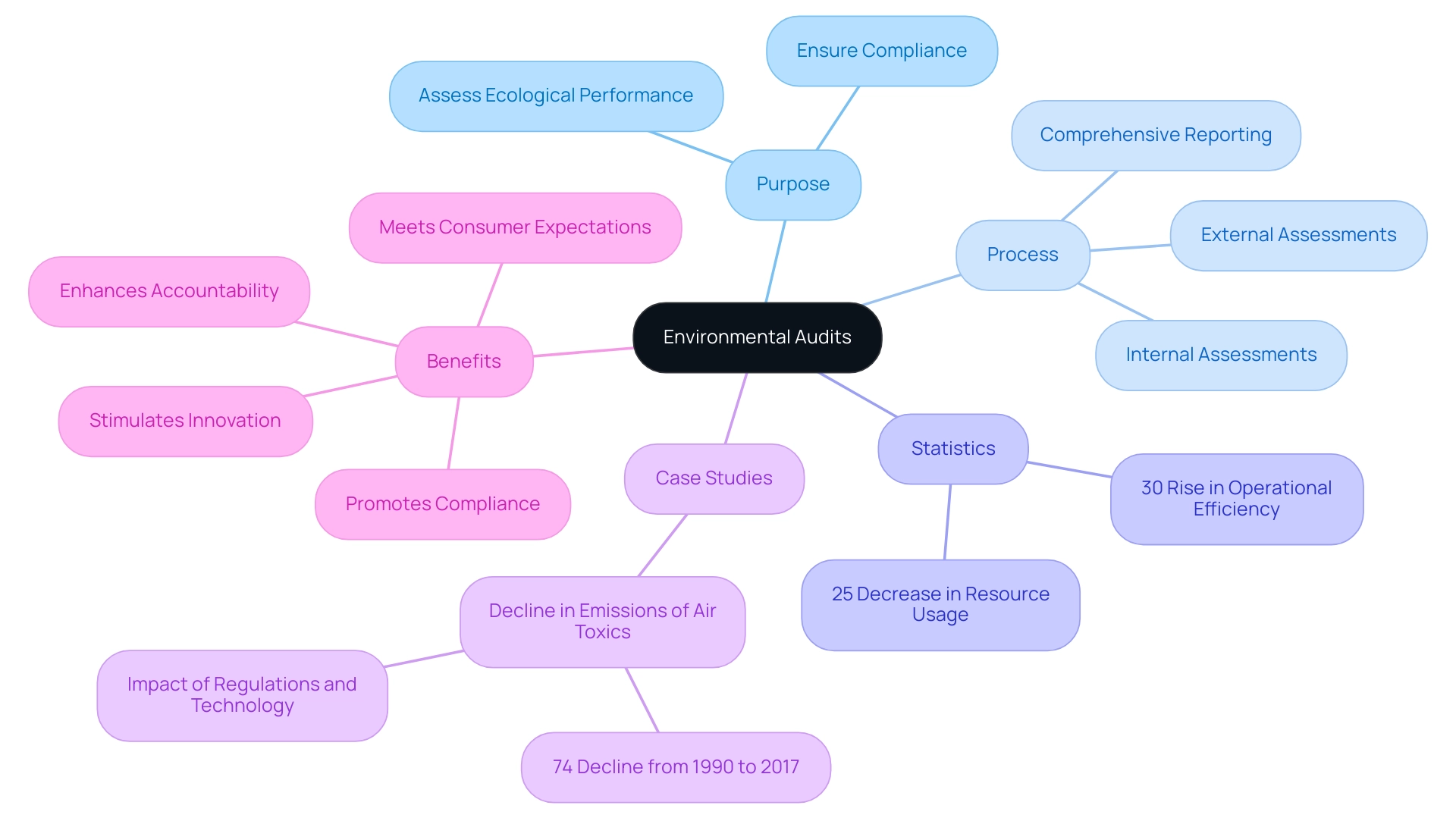
Exploring the Types of Environmental Audits
Environmental assessments are vital resources for entities aiming to improve their sustainability practices. The primary categories of these evaluations include:
- Compliance evaluations
- Management system evaluations
- Performance evaluations
Compliance evaluations are essential for assessing conformity to ecological regulations, ensuring that entities meet the required legal criteria.
As the legal and regulatory structure concerning ecological accounting and auditing progresses, entities must stay alert in their compliance efforts. Management system evaluations measure the efficiency of a company's ecological management systems, concentrating on the implementation of policies and procedures. Performance evaluations, conversely, assess actual ecological performance against set benchmarks, offering insights into the efficacy of sustainability efforts.
In addition to these fundamental types, entities also carry out specific evaluations that focus on essential areas such as:
- Waste management
- Energy efficiency
- Resource conservation
Each evaluation type serves a unique purpose, enabling organizations to identify strengths and weaknesses in their ecological practices. For instance, the significant decline in emissions of hazardous air pollutants—74% from 1990 to 2017—illustrates the effectiveness of regulatory frameworks and technological advancements in driving improvements in air quality.
This case illustrates how compliance assessments, backed by strong regulatory structures, can result in significant ecological advantages. Moreover, the EPA has observed that since 2010, there have been no breaches of the standards for nitrogen oxides (NO), highlighting the effectiveness of these evaluations in encouraging compliance with regulations. As the terrain of ecological assessments changes, especially with the emergence of new kinds of evaluations in 2024, entities must remain aware of compliance review statistics by sector and the most recent trends to manage the intricacies of ecological stewardship efficiently.
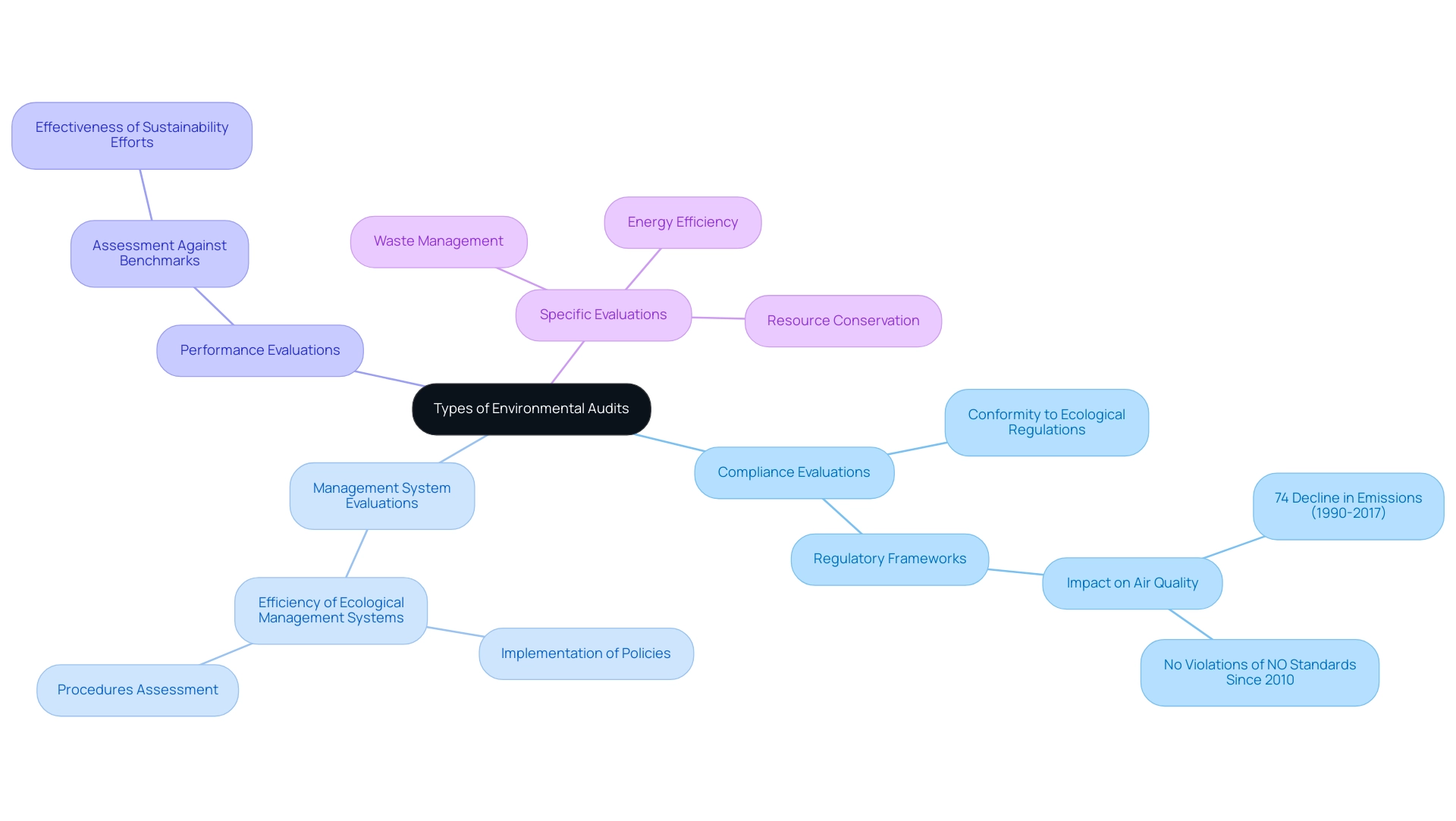
The Benefits of Environmental Auditing
Carrying out ecological assessments can help answer the question of what is an environmental audit and offers numerous benefits that go beyond simple adherence to regulations. These evaluations are essential for improving operational efficiency, as they enable companies to identify inefficiencies within their processes and promote better resource management. Remarkably, companies that implement regular ecological assessments have reported substantial cost reductions; studies suggest that entities can lower operational expenses by as much as 30% through enhanced practices.
As highlighted by Sajag Agarwal, Co-Founder & CEO of OpsNinja, 'Quality is better for consumers, manufacturers, and the planet.' OpsNinja provides extensive quality control services that directly assist in assessments, utilizing approaches that incorporate detailed inspections and evaluations to ensure compliance and ecological balance. Promoting a culture of environmental responsibility within a company not only reduces ecological risks but also enhances stakeholder relations by demonstrating a proactive approach to corporate accountability.
The audit process, which raises the question of what is an environmental audit, typically involves several stages:
- Planning
- Data collection
- Analysis
- Reporting
This ensures comprehensive engagement from experts and stakeholders. Moreover, as we near 2024, the significance of eco-friendliness in attracting environmentally conscious consumers cannot be overstated; brands that show a genuine commitment to sustainable practices, like those backed by OpsNinja, are more likely to earn consumer loyalty and trust. By tackling environmental issues directly and avoiding manufacturing problems through strict quality control, companies can diminish potential legal liabilities, fostering a safer and more compliant operational environment while safeguarding their brand reputation.
OpsNinja imagines a future where retail can be a driving force for global good, and their dedication to quality and environmental responsibility is at the core of this mission.
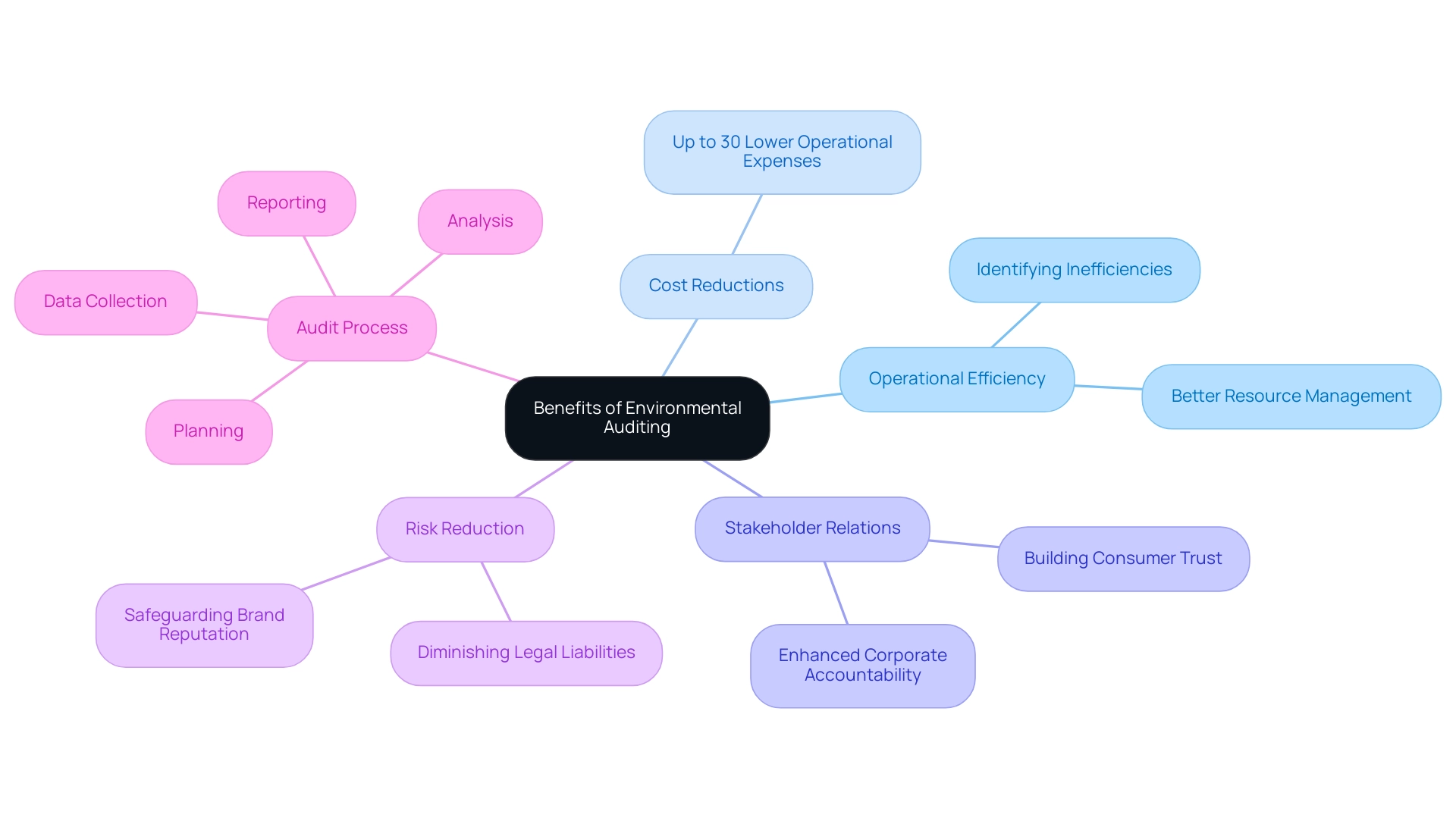
The Importance of Environmental Audits in Sustainability
Organizations dedicated to enhancing their eco-friendly practices often start by asking what is an environmental audit. They provide a structured method for assessing current impacts while identifying areas ripe for enhancement, which raises the question of what is an environmental audit. By incorporating what is an environmental audit into their comprehensive eco-friendly strategies, companies not only ensure compliance with regulatory requirements but also establish measurable goals and track their progress efficiently.
Recent statistics from Front. Environ. Sci. 10:995310 emphasize the rising significance of these evaluations in 2024, as organizations progressively acknowledge their role in improving environmental performance. The examination process typically involves an analysis phase that evaluates collected data to identify areas for improvement, which is part of what is an environmental audit, followed by a reporting stage that provides an overview of findings and recommendations. These evaluations are crucial for understanding what is an environmental audit and for aligning organizational operations with current global eco-friendly initiatives, such as the United Nations Sustainable Development Goals.
This alignment cultivates a culture of accountability and fosters ongoing enhancement of sustainability practices. As Leon Altomonte wisely points out, the incorporation of these evaluations, particularly what is an environmental audit, is crucial for entities aiming to align their operational aims with sustainable goals, emphasizing the idea that sustainability is a developing process rather than a fixed endpoint. Moreover, the case study on 'Workplace Winter Safety Tips' demonstrates the significance of customized evaluation frameworks, highlighting how particular safety measures can reduce risks and improve overall performance, showcasing real-world applications of assessments in aligning with industry best practices.
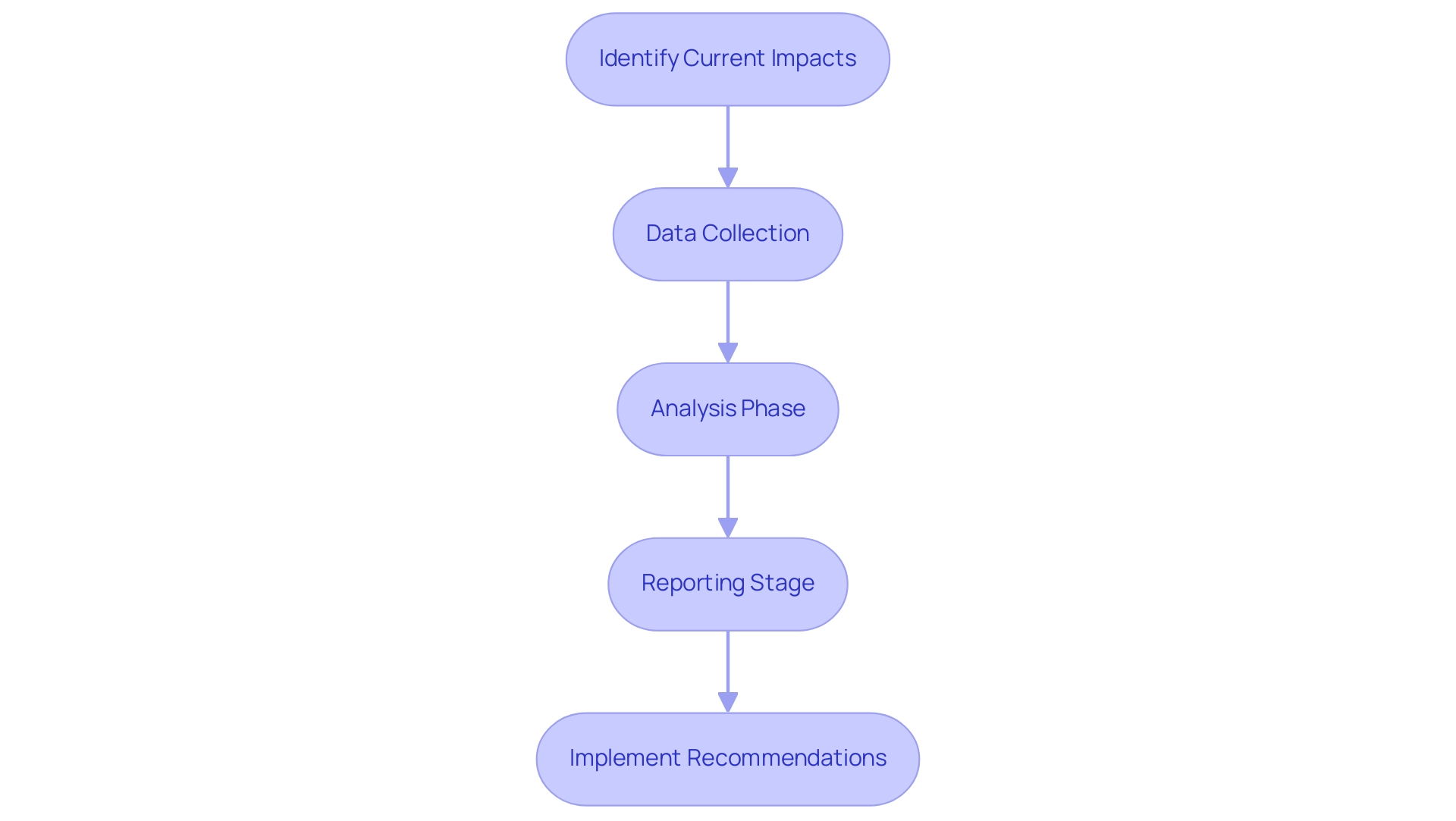
Essential Documentation and Protocols for Environmental Audits
To conduct a thorough assessment of the surroundings, organizations must compile a comprehensive set of essential documentation. This encompasses:
- Environmental policies
- Previous evaluation reports
- Compliance records
- Detailed information regarding resource usage and waste generation
Establishing well-defined protocols is equally crucial. This involves:
- Delineating the review's scope
- Pinpointing key stakeholders
- Establishing clear timelines for completion
Furthermore, entities should provide themselves with the essential tools and resources to enable effective data collection and analysis. As Karin A. Orvis, Chief Statistician of the United States, remarked, "It is anticipated that OMB would be releasing final guidance in an Environmental-Economic Accounting Classifications Manual in 2028," highlighting the significance of organized protocols to improve the dependability and efficiency of ecological assessments.
Auditors may work as internal auditors for businesses or as external auditors for organizations contracted by ecological companies. Furthermore, professional certification as a Certified Environmental Auditor can be obtained from the National Registry of Environmental Professions, enhancing credibility for those performing evaluations. Organizations like those emphasized in the case study have shown that what is an environmental audit can confirm site suitability, demonstrate successful land remediation, and ensure compliance with EPA regulations.
By following these established protocols, organizations not only enhance their auditing effectiveness but also build public confidence in their commitment to environmental safety and regulatory compliance.
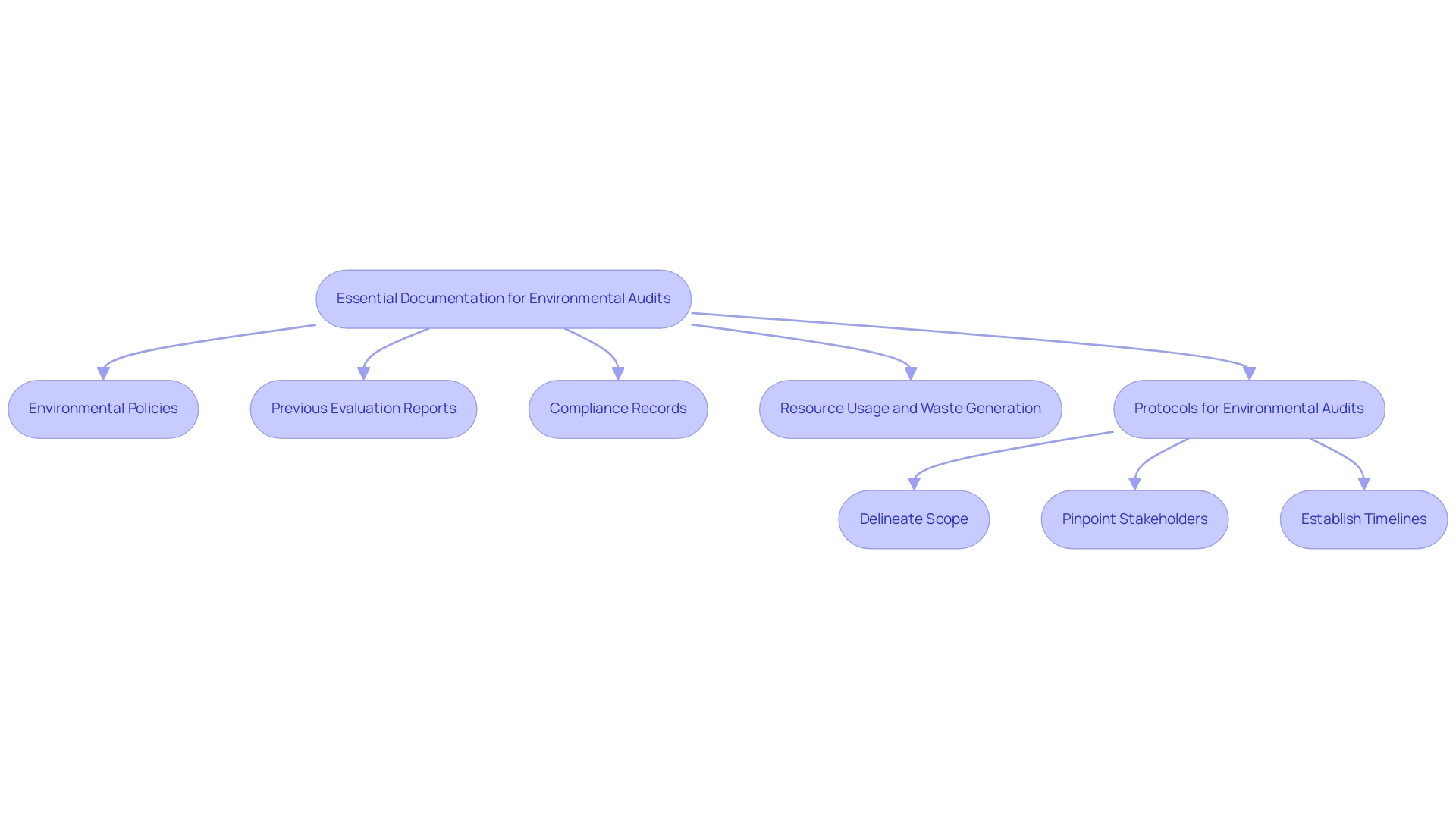
Conclusion
Environmental audits are a pivotal element in the journey towards sustainability for organizations across various sectors. By defining environmental audits and exploring their different types, the article highlights their significance in assessing compliance with regulations, improving operational efficiency, and fostering a culture of accountability. The various audit types—compliance, management system, and performance audits—each serve a unique purpose, enabling organizations to identify strengths and weaknesses in their environmental practices while aligning with contemporary sustainability initiatives.
The benefits of conducting environmental audits extend far beyond regulatory compliance. Organizations that actively engage in these audits can realize substantial cost savings, enhance stakeholder relations, and bolster their brand reputation through demonstrated commitment to sustainability. As the landscape evolves, the integration of environmental audits into corporate strategies becomes increasingly crucial, positioning organizations to meet the expectations of environmentally conscious consumers and to navigate the complexities of environmental management effectively.
To successfully implement these audits, organizations must adhere to essential documentation and protocols that ensure thorough evaluations and actionable recommendations. By prioritizing structured audit processes, businesses can not only fulfill regulatory requirements but also drive innovation and continuous improvement in their sustainability efforts. Ultimately, environmental audits serve as a vital tool for organizations striving to create a positive impact on the planet while achieving their operational goals, reinforcing the notion that sustainability is an ongoing commitment that benefits both the organization and the broader community.



